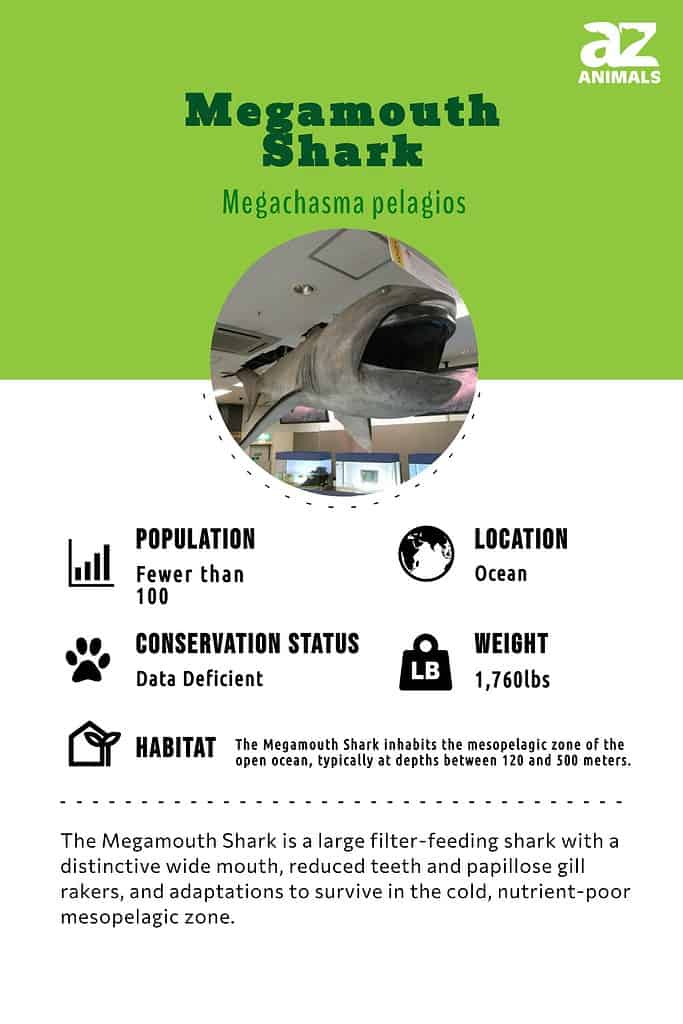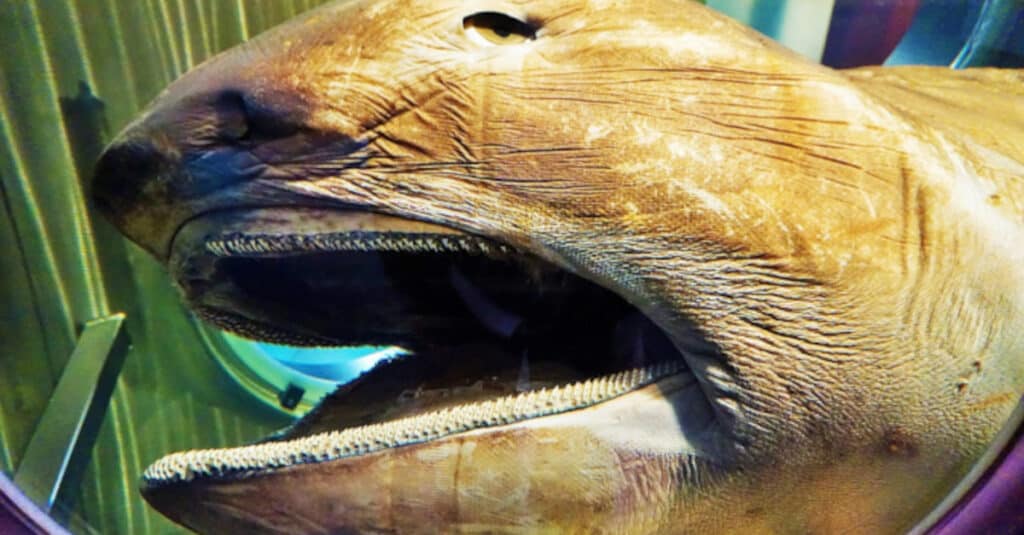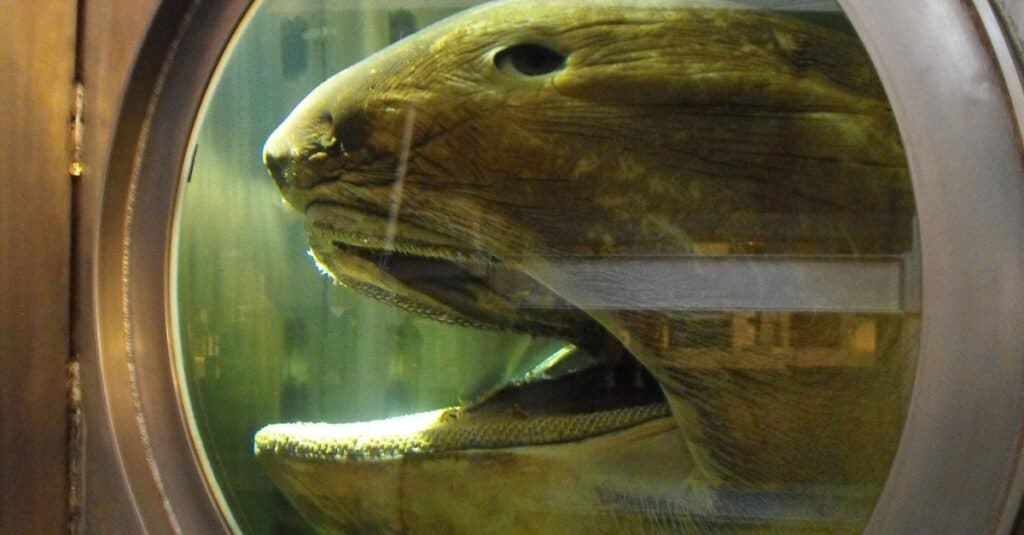Swims with its mouth open to capture prey
Advertisement
Megamouth Shark Scientific Classification
- Kingdom
- Animalia
- Phylum
- Chordata
- Class
- Chondrichthyes
- Order
- Lamniformes
- Family
- Megachasmidae
- Genus
- Megachasma
- Scientific Name
- Megachasma pelagios
Read our Complete Guide to Classification of Animals.
Megamouth Shark Conservation Status
Megamouth Shark Facts
- Main Prey
- Plankton, jellyfish, shrimp, copepods
- Group Behavior
- Solitary
- Fun Fact
- Swims with its mouth open to capture prey
- Estimated Population Size
- Unknown
- Biggest Threat
- Incidental bycatch
- Most Distinctive Feature
- Tremendously large mouth full of teeth
- Other Name(s)
- Big mouth shark
- Gestation Period
- Unknown
- Habitat
- Oceans
- Diet
- Carnivore
- Type
- Cetorhinidae
- Common Name
- Megamouth shark
- Number Of Species
- 1
View all of the Megamouth Shark images!

The megamouth shark is also known as the big-mouth shark.
One of the most interesting facts about this shark is it was first spotted just a few decades ago in 1976. It’s a deepwater shark that’s rarely seen by humans making it all the more mysterious.
The megamouth shark swims along slowly with its tremendous mouth open sucking in small sea creatures such as plankton, shrimp, and krill. This process is called filter feeding.
3 Incredible Megamouth Shark Facts!

Megamouth shark in WA Maritime Museum.
©GordonMakryllos / CC BY-SA 4.0 – License
- The slow lane: Most people think of sharks as fast, agile swimmers. However, these sharks are awkward, slow swimmers reaching a top speed of just 1.30 mph.
- Tiny teeth: These sharks have 50 rows of teeth on their upper and lower jaws.
- A glowing mouth: Megamouth sharks have glowing pores around their mouths. Marine biologists believe krill, plankton, and other small sea life are attracted to these glowing pores. This attraction causes them to swim right into the shark’s mouth without knowing it.
Evolution and Origins
In 1976, a megamouth shark named Megachasma pelagios was caught by chance in Kāne’ohe, Hawai’i. It was later identified as a new species in 1983 by Taylor, Compagno, and Struhsaker. Despite being known for over 40 years, there have been only around 100 documented captures or sightings of this shark species so far.
The megamouth shark has several unique adaptations for filter-feeding, such as having significantly fewer teeth and gill rakers with small bumps called papillae.
In addition, the shark has made specific adaptations to survive in the cold and nutrient-deficient mesopelagic zone, including soft muscles and a skeleton that is not well-calcified.
Classification and Scientific Name

Megamouth shark, Megachasma pelagios, at Toba Aquarium, Japan
©Opencage / CC BY-SA 2.5 – License
The scientific name of this shark is Megachasma pelagios. It’s known as the megamouth shark and sometimes called a big-mouth shark. It belongs to the Megachasmidae family and is in the Chondrichthyes class.
Megamouth sharks belong to the genus Megachasma. The Greek word mega chasma translates to great (megas) cave (chasma).
This shark is one species belonging to the Megachasmidae family. It’s similar to (but smaller than) a couple of other filter-feeding sharks including the basking shark and the whale shark.
Appearance
The upper half of a megamouth shark is black, gray, or brown while its belly is cream or white. This deepwater shark is covered in scales, also called denticles. Denticles are different sizes and shapes depending on where they are on a shark’s body. They serve to protect the shark’s body from sharp rocks. Denticles also protect a shark from parasites.
These sharks have rounded heads featuring huge mouths. In fact, its mouth can measure four feet across! This shark’s mouth is full of small, hooked teeth. They have two small dorsal fins as well as a large pectoral fin and caudal fin.
Male megamouth sharks grow to an average of 13 feet long while females average 16 feet in size. The average weight of this shark is 1,760 pounds. Male sharks can reach a size of 18 feet. Alternatively, the maximum length for a female shark is 23 feet.
In fact, 23 feet is the record for the longest megamouth shark. The heaviest megamouth shark on record registered a weight of 2,679 pounds!

©Saberwyn / CC BY-SA 3.0 – License
Distribution, Population, and Habitat
These sharks live in tropical, temperate oceans including the Indian, Pacific, and Atlantic oceans. Back in 1976, the first sighting of this shark occurred near the Hawaiian coast. Since then, they have been seen off the coast of Australia, Africa, Mexico, and even California.
There seem to be more sightings of them close to Asia. Specifically, they’ve been seen off the coast of Taiwan, Japan, and the Philippines. Megamouth sharks can swim at depths of 15,000 feet as well as near the surface. These saltwater sharks move to different depths of the ocean to find prey.
These large sharks remain hidden from humans most of the time. But just because they are hidden doesn’t mean this species is Extinct. The IUCN Red List of Threatened Species states that the population of this shark is unknown, but it has a conservation status of Least Concern.
Predators and Prey
These sharks are carnivores, filter-feeding on very small prey. This means it swims along slowly with its mouth open, sifting through the water in search of small sea creatures to eat.
What eats the megamouth shark?
Sperm whales and cookie-cutter sharks are two predators of megamouth sharks. The much larger sperm whale can easily cause injury to a megamouth shark. Also, though a cookie-cutter shark is much smaller in size than a megamouth shark, it’s known to take large bites out of other sea creatures. This type of bite can cause serious injury.
Humans are also predators of these deepwater sharks. When an adult or juvenile sharks end up in commercial fishing nets, it’s usually by accident.
The conservation status of this shark is Least Concern. The biggest threat to this species is getting caught in a fishing net. Though this is a significant threat, it hasn’t put them in danger of going extinct.
What does the megamouth shark eat?
The prey of this shark includes krill, plankton, jellyfish, shrimp, and copepods.
Reproduction and Lifespan
These sharks are sexually mature when they reach a size of around 13 feet long. The shark babies, or pups, develop inside the female. The pups nourish themselves on yolk sacs inside their mother. The gestation period along with the number of pups in a litter are both unknown. But marine biologists know the mother gives live birth to her pups, and they begin filter-feeding right away. The lifespan of these sharks is unknown.
Fishing and Cooking
Commercial fishermen don’t go out in pursuit of these sharks. However, these large sharks sometimes end up in commercial fishing nets meant for other fish. This is referred to as bycatch. A shark may die after being trapped in a commercial fisherman’s net. Or, if it’s still alive, fishermen may set it free.
View all 164 animals that start with MMegamouth Shark FAQs (Frequently Asked Questions)
Where are megamouth sharks found?
Megamouth sharks swim in temperate, tropical waters and have been seen in the Pacific, Atlantic and Indian Oceans. While they spend time swimming near the surface, their main habitat is deep underwater. There have been sightings off the coast of Australia, Africa, Mexico, and the Philippines just to name a few.
What does a megamouth shark eat?
This filter-feeding shark moves through its habitat eating krill, plankton, jelly fish, shrimp, and copepods.
Are megamouth sharks dangerous?
No. Though they can reach a size of 18 feet or longer and register a weight of over 2,000 pounds, these sharks are not dangerous. In fact, they have been described as gentle.
Why are megamouth sharks rare?
These deepwater sharks are considered rare because they simply aren’t seen very often. This is another reason why there are so few facts known about this species!
How many megamouth sharks are left?
The population of the megamouth shark along with its lifespan are unknown. But remember, just because they are rarely seen doesn’t mean they’re extinct.
Do megamouth sharks have teeth?
Yes. Marine biologists who study the megamouth shark have noted the presence of 50 rows of tiny teeth on its upper and lower jaws.
What is the difference between a Megamouth Shark and a Great White Shark?
The main difference between a megamouth shark and a great white shark is that megamouth sharks are deepwater filter feeders, while great whites are surface-dwelling apex predators.
Thank you for reading! Have some feedback for us? Contact the AZ Animals editorial team.
Sources
- Florida Museum, Available here: https://www.floridamuseum.ufl.edu/discover-fish/species-profiles/megachasma-pelagios/
- Oceana, Available here: https://usa.oceana.org/blog/shark-fact-friday-12-super-scales
- Wikipedia, Available here: https://en.wikipedia.org/wiki/Cookiecutter_shark
- NOAA Fisheries, Available here: https://www.fisheries.noaa.gov/species/sperm-whale


















